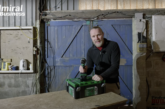
Tibby Singh finds his level with the Laserliner PocketPlane-Laser 3G

Over the years the technology behind levels has developed – and now the most popular method seems to be using laser levels. There are many brands on the market, but people are always reluctant to explore names they aren’t familiar with. When I was introduced to the Laserliner PocketPlane-Laser 3G Set 150cm, I wanted to establish if it was on the same level as others in the sector. Laserliner is a company with a strong pedigree. The German manufacturer started manufacturing professional tools for measuring, detection and levelling over 25 years’ ago.
My first thought is how small and compact it is. In fact, it’s the smallest laser level I’ve ever seen. So, it stands by its name of being a pocket level, and fits straight into my holster pocket, which means it’s always close to hand. As expected, it is a green laser, which is more advanced than a red laser, with better visibility. Considering how small it is, it still has three dimensions – one horizontal and two vertical laser lines. It has the option to use just the horizontal or vertical dimension depending on the job.

is a very compact laser level
Having these functions allows you to set out and mark out for tasks such as stud work and get the right angle without the need for further calculations, or the need to remember Pythagoras from your school days. Then there is the option to lock the laser in place to create a manual slope of any desired angle, without the laser continually flashing – which can be distracting – but there is an occasional flash every few seconds to remind you that it is not in the self-level mode.

There is a battery indicator at the top of the laser, which is useful although not very common on these tools. Another advantage of this laser is its built-in rechargeable battery, which is charged by a USB-C lead, which is also provided. The runtime is a lengthy nine hours, and that is with all three laser levels turned on. I noticed another button at the top of the laser, to activate the hand receiver mode, which can be used in conjunction with the laser. The benefits of this include greater accuracy, even if there is reduced visibility, such as when you’re working outdoors, but also allows the laser to be used over greater distances. It is claimed that it can be used for up to 60m with the receiver, and typically 30m without.

The laser comes with other handy accessories for various jobs. These include the target plate and green glasses, which enhance the light, increasing accuracy in brighter working conditions. Then there is the pocket wall holder, which easily screws to the laser and can then be screwed to the wall or, alternatively, it is magnetic so it can be stuck to a metal surface. The height of this holder can be finely adjusted using the rotating knob, so you don’t need to worry about setting it accurately, as there is some tolerance.

In this set, you also get the 150cm tripod stand, which can be used directly with the laser, or in combination with the wall holder. It’s made of multi-section telescopic tripod legs at the bottom and a 30cm crank at the top, allowing for an extensive adjustment range of up to 150cm. This is ideal for when it comes to fitting kitchens, as it can be set up independently to the required height. The tripod folds up and can be placed in the hard carry case, along with all the other accessories and the laser itself, to protect it from being knocked and damaged in transport.

3G has a green laser,
which has a greater
level of visibility
It’s safe to say this Laserliner PocketPlane-Laser 3G 150cm has proven that good things come in small packages. Although it may not currently be a common name, it’s a quality product fully backed by the manufacturer’s 4-year guarantee, giving you that extra peace of mind. We will be seeing more of these lasers as well as other Laserliner products on the jobsite, such as the wall scanner, moisture finder and pocket camera, which I’m excited about testing in the next review.
For further information on the Laserliner PocketPlane-Laser 3G visit Laserliner: Innovation in Tools – Leading branded products in Modern Measuring Technology.
Tibby Singh – www.TibbySingh.com







